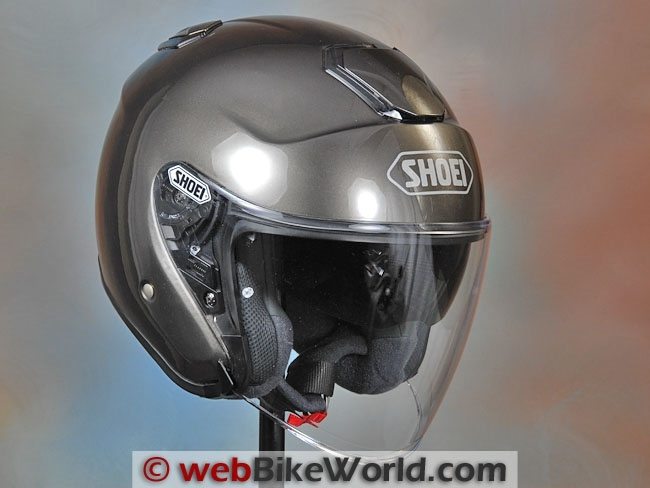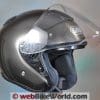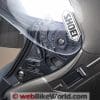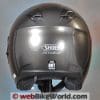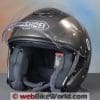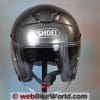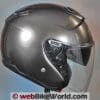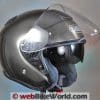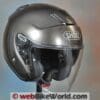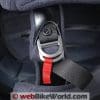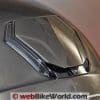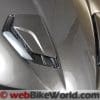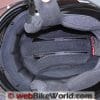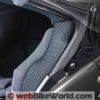The new Shoei J-Cruise replaces the popular and long-lived Shoei J-Wing helmet.
The J-Cruise feels just like a full-face helmet…but without a chin bar.
In other words, it has all of the features and build quality you’d expect from a Shoei helmet.
This includes the outstanding ventilation that has become a Shoei trademark, also implemented on the Shoei GT Air (review) and other recent Shoei helmets.
The J-Cruise includes the excellent internal sun visor system found on the GT Air, which is enclosed in a special chamber in the brow that doesn’t reduce the thickness of the EPS protection in that area.
And the sun visor uses the same optical-grade polymer that Shoei uses in the GT Air, which makes a big difference in visual quality.
The bottom line? The Shoei J-Cruise is by far the most solid-feeling open-face helmet we’ve reviewed by far.
It’s a full-face helmet in an open-face shell. Motorcycle riders who don’t like the feeling of a full-face helmet will find a lot to like.
We don’t review many open-face helmets on webBikeWorld, simply because most of the evaluators and reviewers don’t usually wear one.
But that may change with the new Shoei J-Cruise.
It’s basically a full-face helmet in an open-face shell; in other words, you give up the protection of a chin bar but there really aren’t any other compromises to be made.
The J-Cruise replaces the Shoei J-Wing, a helmet we never did get to review. But the J-Cruise is new in every way and it incorporates all of the latest Shoei design themes and technology found in helmets like the Shoei GT Air (review), the Shoei Qwest (review) and the Shoei Neotec (review).
In fact, the Shoei helmet lineup probably has more consistency in terms of design than it ever did before…right down to the “Shoei fit”, which is what we call a “Slightly Narrow” profile.
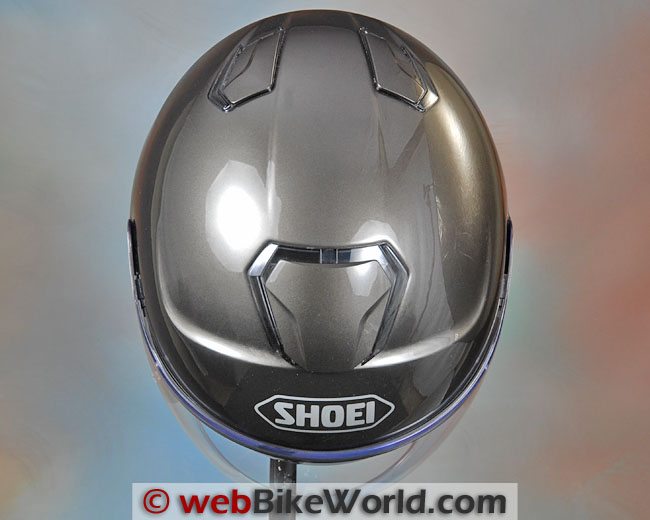


The Shoei J-Cruise: Paint, Graphics and Overall Quality
Our J-Cruise in Anthracite Metallic has the same outstanding Shoei quality we’ve come to expect from the brand. It’s one of the features you pay for but the difference is noticeable.
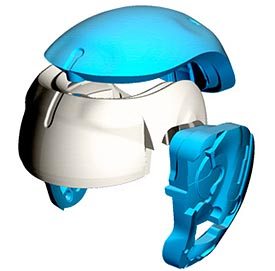

This particular helmet in this color reminds us of the Shoei Qwest and Neotec we reviewed.
The features carry the same design and styling themes and the Anthracite Metallic color is used in several other Shoei helmets.
The movement and feel of the vents and the large face shield all have a quality feel that makes this helmet special.
And the same plush Shoei liner and padding is included.
Shoei seems to be a bit coy about the shell construction on the J-Cruise.
But the paint quality is outstanding also, with a thick-feeling clear coat that should provide good protection for the entire five-year warranty period and beyond.
Also, the new internal sun visor design that we described in the GT Air review has also been incorporated into the J-Cruise.
The sun visor is optical grade quality and that makes a big difference. The clarity is definitely noticeable and makes all other internal sun visors seem cheap in comparison.
And Shoei listened to our gripes about “on/off” sun visors; this one uses a simple friction design that allows the sun visor to be stopped in any intermediate position, while still providing enough coverage fully lowered.
Score: The Shoei J-Cruise gets an “Outstanding” rating for paint and overall quality. See the Summary Table at the bottom of the page for a description of our rating system.
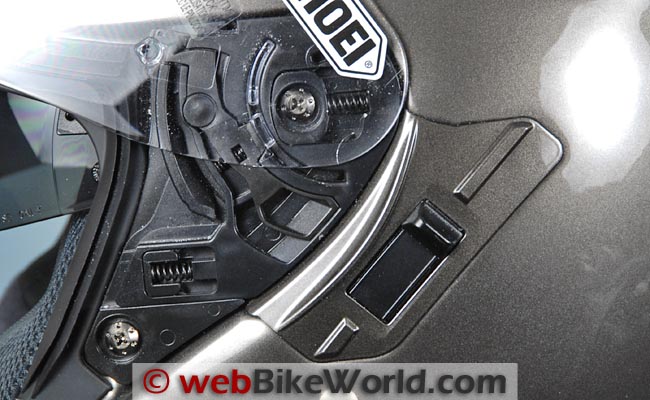


Shoei J-Cruise Fit, Sizing and Internal Shape
The term “Shoei fit” has been thrown about in the past by motorcyclists but we didn’t think that there really was such a thing until recently.
But we’ve noticed that the GT Air, the Qwest, RF-1100, Neotec and other recent Shoei helmets all seem to have what we call a “Slightly Narrow” internal shape and they’re all similar enough that this can now indeed be termed “the Shoei fit”.
This is both good and bad news, however. It’s good news for “Neutral” to “Slightly Narrow” head shapes (the majority), but bad news for “Round” head minorities like me (Rick).
My head is widest at the temples, and the recent Shoei helmets just don’t fit as comfortably as I’d like, which is a real shame.
“Burn”, however, is a Shoei-head through and through…as is the majority, apparently. But I do wish Shoei would recognize the fact that there are head shapes like mine and make helmets to match.
For more information on human head shapes, be sure to read the interesting report on theHohenstein Institute head shape study we published recently, or the webBikeWorld Motorcycle Helmet FAQ and Motorcycle Helmet Shapes list.
Anyway, the J-Cruise has a very comfortable (and removable) liner with the same plush fabric and padding used by Shoei for many years. The helmet fits and feels just like a full-face Shoei — and that’s a definite plus.
Like the GT Air, Shoei lists a 59-60 cm for the size large J-Cruise and that seems accurate. We also tried a size XL J-Cruise, which is listed as fitting a 61-62 cm head, and that seems accurate as well, so our assumption is that the helmet runs true to size.
The shell is fairly stiff, so there’s not as much play or stretch as there might be in some of the less expensive open-face helmets. So if you’re on the borderline, we’d suggest ordering according to the Shoei size charts.
The internal shape is biased towards the “Slight Narrow” part of the spectrum (as described in the webBikeWorld Motorcycle Helmet Shapes page), with narrower sides and lots of fore/aft room in the top.
Also similar to the GT Air is the design of the “bump” on the forehead to house the internal sun visor. This new Shoei design allows the full thickness of EPS in the liner to be maintained for safety and protection.
And the inclusion of the internal sun visor doesn’t intrude on the room inside the helmet either; in fact, there is plenty of forehead or front-to-back room up top with this design, so riders who experience forehead pressure may be pleased with the fit of the J-Cruise.
The EPS in the ear pockets has round cutouts for speakers but — like the GT Air — I’m not sure which speakers exactly will fit. Perhaps Shoei is considering a partnership with an intercom manufacturer? The ear pockets are very nicely lined and sized correctly.
Also like the GT Air, a “Round” head may have some problems fitting a pair of eyeglasses or sunglasses inside the J-Cruise, due to the narrower fit at the sides. But “Burn” has no problem at all.
Overall, we rate the Shoei J-Cruise as very comfortable and it should fit the average head shape.



More information on helmet fit can be found in the webBikeWorld Motorcycle Helmet FAQ page, along with the chart that lists the helmet weights of webBikeWorld reviewed helmets and also by shape on the webBikeWorld Motorcycle Helmet Shapes page.
Score: The Shoei J-Cruise gets an “Outstanding” rating for comfort and liner materials and padding and a comfortable fit.
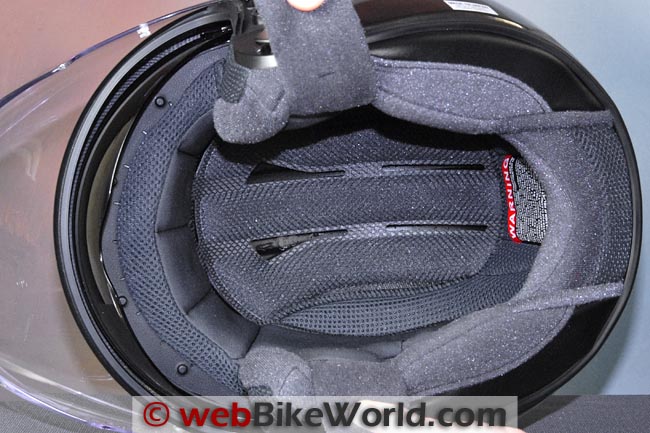


Shoei J-Cruise Face Shield, Visibility and Internal Sun Visor
Shoei said that the CJ-2 face shield on the J-Cruise was completely redesigned, making it wider and taller than its predecessor on the J-Wing.
Having no experience with the J-Wing, we can’t comment on that. But there’s no doubt about it — the visibility from the J-Cruise is virtually unlimited, and that’s one of the main advantages of going to an open-face helmet.
It makes a big difference to be able to see so much more in front and below — especially for some cruiser owners whose rides have the speedometer and other instruments on the fuel tank.
The face shield provides near full-face coverage also in terms of wind protection and Shoei says it blocks 99% of UV light. The bottom of the face shield or visor is nearly even with the bottom of the chin; much better than most of the other open-face helmets we’ve reviewed.
The face shield also has a locking tab or button at the lower left that has no moving parts. The visor has a small molded indent that fits over a dimple in the receiver on the shell.
Push out slightly on the face shield and it pops out and can then be lifted upwards through its one detent travel. The single detent is right at the top of the travel, which keeps the face shield from closing if you’re traveling with “shields up”.
The clarity and optical quality of the face shield is outstanding; Shoei also said that a special molding process is used to eliminate distortions across the wide surface.
Ditto for the internal sun visor, which is optical grade sunglasses quality, claimed by Shoei to “exceed the ANSI Z80.3-2010 Standard for non-prescription eyewear”. This makes a real and noticeable difference.
The sun visor also rotates down far enough and it’s a very useful addition to the helmet, especially with that huge outward visibility provided by the big face shield. This is quite different from the Arai approach taken with the Arai CT-Z (review), which had some glare issues as we noted in the review.
The J-Cruise face shield is also ready to accept a Pinlock anti-fog insert (review) which, surprisingly, is not included, even at the lofty list price of the helmet. It’s also interesting to note that there’s a sticker on the J-Cruise face shield that reads “Daytime use only with Pinlock”.
The top of the face shield is molded with a lip that seals against the rubber gasket to prevent water from entering along the top of the eye port. The visor removal system is very easy to use and is illustrated in our video below.



Score: The Shoei J-Cruise gets an “Outstanding” rating for the overall quality and operation of the face shield and the quality and operation of the internal sun visor.
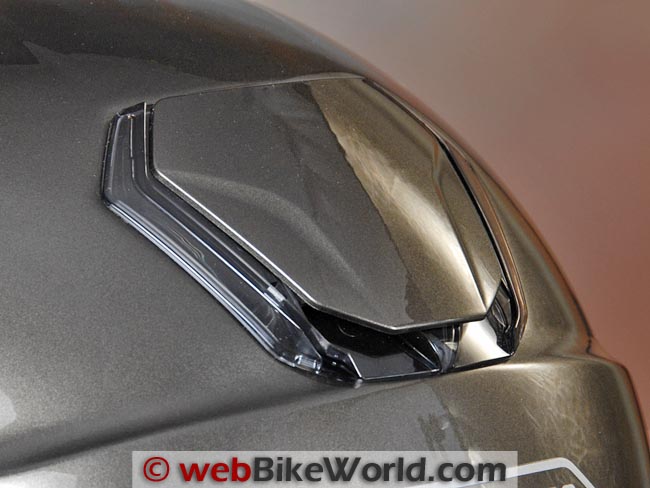


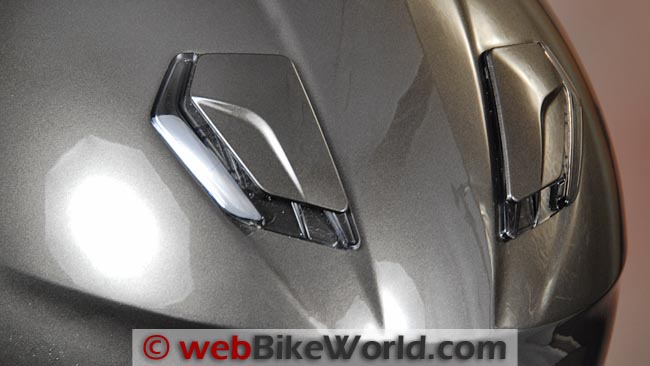


Ventilation
Yet another similarity between the J-Cruise and the GT Air is the outstanding ventilation system provided by the similar-looking top vents on both helmets.
Inspecting the top vent on the J-Cruise doesn’t reveal anything unusual; in fact, the design appears at first glance to have a lower profile than many of the upper vent systems we’ve seen.
But it really works, and the air is directed down on to the rider’s head through two huge vent holes through the EPS. The liner is also specially designed to match the vent holes, and the system does the trick.
In fact, like the GT Air, the J-Cruise is one of the few helmets we’ve ever reviewed which flow so much air that we actually have to close the vent in cool weather!
That seems logical but it’s actually very rare, simply because most motorcycle top vent systems are pathetic, to say the least.
The flat slider on the top/front vent has two positions, as do the dual rear exhaust vents, which can be left open most of the time whether the front vent is open or closed.
The J-Cruise does have a lot of air flowing in from under the face shield, as expected for an open-face design. But the face shield is also very large and the air coming in from underneath doesn’t feel much different from the average full-face helmet without a chin curtain.



Score: The J-Cruise ventilation system gets an “Outstanding” overall rating overall.
Shoei J-Cruise Noise Levels
Open-face helmets are almost always louder than full-face helmets. The open bottom and sometimes too-short visors can create a lot of noise.
The large face shield and the solid shell design of the J-Cruise helps to reduce this to a minimum though, at least for an open-face helmet. We think the noise levels are somewhere near the average for full-face helmets, which is a positive in this case.
When riding behind a windscreen with the top of the helmet out in the air flow, the ventilation still works well and it’s quieter than expected.
Some engine noise echoes up from underneath the front of the face shield and when wearing the J-Cruise on a motorcycle without a windscreen, the air noise around the bottom can be heard.
The vents are very quiet though, especially considering the amount of air flowing in. So overall, we rate the Shoei J-Cruise as quieter than average for an open-face helmet, especially when riding behind a windscreen.



Note that our helmet evaluations are a combined effort of several riders over time on different types of motorcycles with and without windscreens.
Evaluators wear correctly fitted, high quality ear plugs (even when evaluating motorcycle intercom systems).
Always protect your hearing when riding a motorcycle. See the wBW Earplug Reviews for more information on choosing and wearing earplugs.
Note also that perceived noise levels will vary, depending on the individual.
Noise can be caused by many factors, including helmet fit, the type of motorcycle and windscreen, wind speed and direction and even the rider’s clothing.
For more information on helmet noise, visit the wBW Motorcycle Helmet Noise page.
Score: The Shoei J-Cruise gets an “Excellent” rating for noise control.
Helmet Weight
This Shoei J-Cruise in size large weighs 1610 grams (3 lbs., 8-3/4 oz.), roughly the equivalent of full-face helmets we’ve reviewed such as the size XL Roof Boxer V8 (review) (a flip-up) at 1609 grams; the Shoei RF-1000 (review) in size XL at 1610 grams and the Arai Vector 2 (review) in size L at 1611 grams.
The J-Cruise is the heaviest open-face helmet we have reviewed, with the AFX FX-50 (review) in size L weighing 1525 grams and the Arai CT-Z (review) in size L weighing in at 1564 grams.
More webBikeWorld.com open face helmet weights can be found here in the separate table for open-face helmets (which are not included in the graphic on the Helmet Weights page).
Otherwise, the balance is very good and, like the GT Air, considering the fact that an internal sun visor is included, the weight is reasonable.
Note also that all of the helmets reviewed on webBikeWorld have been weighed and the weights are available on the wBW Motorcycle Helmet Weights page, along with a chart that lists the helmets by weight and shape on the wBW Motorcycle Helmet Shapes page.
Score: The Shoei J-Cruise gets a “Very Good” rating for its weight and good balance.
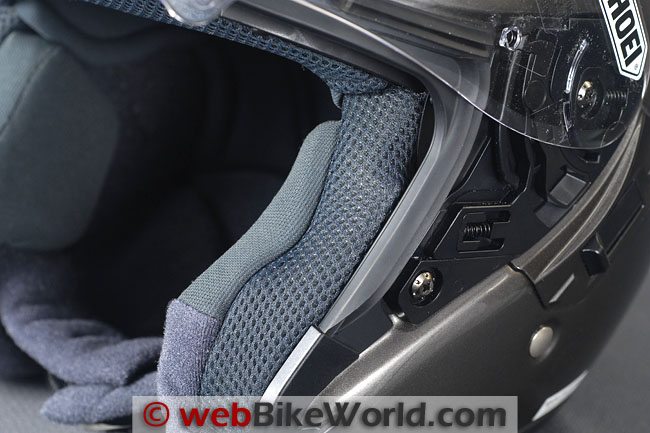

Miscellaneous
The J-Cruise has a double D-ring chin strap retainer. The padding feel and length is comfortable.
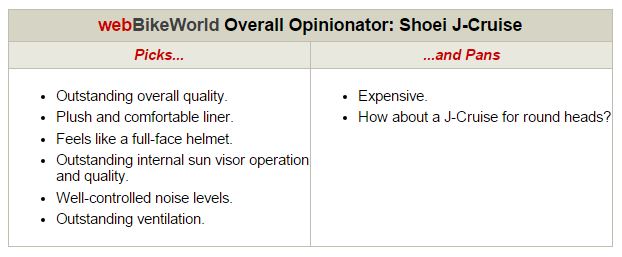


Conclusion
The new Shoei J-Cruise has to be one of the nicest open-face designs we’ve reviewed. It feels substantial and other than the absence of a chin bar, it feels very similar to a Shoei full-face helmet — and that’s probably about the best compliment that can be given.
Touring riders or cruiser owners with a “Slightly Narrow” head shape should be very pleased with the J-Cruise.
And although we never got a chance to review its predecessor, the J-Wing, the J-Cruise is one nice open-face helmet and it’s also a helmet we would consider wearing on a regular basis.
Like other Shoei helmets, it’s expensive. But also like other Shoei helmets, it has all of the details that and a build quality that give one confidence, especially compared to some of the less expensive open-face helmets we’ve tried.
Owner Comments and Feedback
See details on submitting comments.
From “G.J.” (August 2013): “This helmet doesn’t work for me as my ears begin to ache and continue down to the jawbone after about a half hour or so of riding I’ve never had a helmet do this before including other Shoei’s that I’ve owned.
I usually ride with ear plugs and even tried riding without ear plugs.
Plus, I also tried removing the ear inserts in the helmet but this didn’t work either and it doesn’t matter what kind of bike I ride naked or faired I still have problems with my ears hurting mostly on my right side from wearing this helmet.
No other helmet that I have gave me this kind of problem.
I have a similar Shark RSJ helmet that works just fine but doesn’t flow as much air which is why I bought the Shoei. The Shark was on closeout at 150.00 and I tend to wear this helmet more while the more expensive Shoei is back in a box sitting on a shelf.
Plus I found the Shoei noisy and the vents will whistle with the shield up. I rate this Shoei a big disappointment.
From “J.W.” (May 2013): “In my one crash, I skidded across the pavement on my stomach, face down. The chin bar on my full face helmet was clearly abraded. Without a full face helmet, I would have sustained some very serious disfiguring injuries.
Open face helmets may be great but only if you know how you are going to land.”


